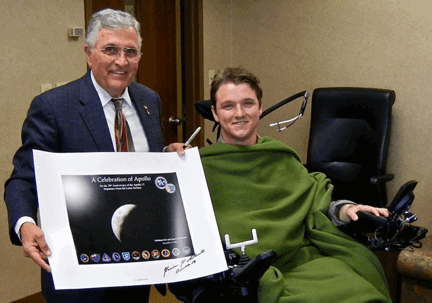NEEP602 Course Notes (Spring 1996)
Resources from Space
Lecture #29: One Small Step and One Big Kick!
Title: Chemical Rockets
April 3, 1996
Note: This page has not been used in our Resources from Space course for several years, and it is only infrequently maintained. Please inform me of any broken links.
Please see our most recent Resources from Space course web page, which contains, among other information, updated links to web pages on
- Spacecraft Trajectories
- Plasma and Electric Propulsion
- Fusion Propulsion
- Chemical Propulsion (by Michael Griffin, a true chemical rocket expert)
Chemical rocket overview
Some rocket-history documents on the Web include A Brief History of Rocketry (from a rather American perspective), a History of Marshall Space Flight Center, where a great deal of US rocket development occurred, and a fairly comprehensive document History of Space Exploration. Highlights include:| Year | Event |
|---|---|
| 300 BC | Gunpowder-filled bamboo tubes used for fireworks in China |
| 1045 | Military rockets in use in China |
| 1895 | Konstantin Tsiolkovsky derives the fundamental rocket equation |
| 1926 | Robert Goddard launches first liquid-fueled rocket |
| 1942 | Wernher von Braun's team launches first successful A4 (V2) |
| 1957 | Sputnik launch |
| 1958 | Explorer I launch |
| 1967 | Saturn V first launch |
| 1969 | Apollo 11 Moon launch |
Specific impulse
The impulse, , given to a rocket is the thrust force integrated over the burn time. Traditionally, for the case of constant exhaust velocity (), the specific impulse has been used: , where is the propellant mass and is Earth's surface gravity. In English units, is thus measured in seconds and is a force per weight flow. Often today, however, specific impulse is measured in the SI units meters/second [m/s], recognizing that force per mass flow is more logically satisfying. The specific impulse is then simply equal to the exhaust velocity, .Chemical rocket fuels
Two main classes of chemical-rocket fuels exist, liquid and solid. A good introductory discussion of chemical-rocket fuels can be found by clicking here. The advantages of liquid-fueled rockets are that they provide- Higher exhaust velocity (specific impulse),
- Controllable thrust (throttle capability),
- Restart capability, and
- Termination control.
- Reliability (fewer moving parts),
- Higher mass fractions (higher density implies lower tankage), and
- Operational simplicity.
| Liquid propellants | ||
|---|---|---|
| Fuel | Oxidizer | Isp (s) |
| Hydrogen(LH2) | Oxygen (LOX) | 450 |
| Kerosene | LOX | 260 |
| Monomethyl hydrazine (MMH) | Nitrogen tetroxide (N2O4) | 310 |
| Solid propellants | ||
| Fuel | Oxidizer | Isp (s) |
| Powdered Al | Ammonium perchlorate | 270 |
Rocket efficiency
| When the total kinetic energy of the rocket and its exhaust are taken into consideration, the highest efficiency occurs when the exhaust is equal to the instantaneous rocket velocity, as shown in the figure at right. See Sutton for a discussion. | 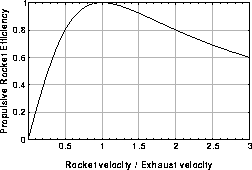 |
Ascent from planetary surfaces
| Effect | |
|---|---|
| Key effects that come into play during launch from planetary surfaces are shown at right. Gravity reduces the effective acceleration, and it is generally the most important force. Atmospheric drag can create significant friction, both heating and slowing a rocket. The coriolis and centrifugal forces due to the planet's rotation are usually small effects, but the planet's rotation can often be used to give the rocket an initial velocity in a desired direction. | Gravity |
| Atmospheric drag | |
| Coriolis force | |
| Centrifugal force | |
| Wind velocity | |
| Planetary rotation |
Launch criteria
Various criteria are used to decide when to launch a rocket. For the Space Shuttle, these include- Launch window
- Weather
- Wind conditions
- Lightning and cloud cover
- Temperature
Engine design
| F-1 engine | |
|---|---|
| Chemical-rocket engines are technological marvels, combining knowledge of physics, chemistry, materials, heat transfer, and many other fields in a complicated, integrated system. The F-1 engine used in the first stage of the Saturn V rockets that launched the Apollo missions appears at right. | 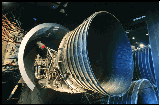 |
Heat transfer
Heat transfer presents a critical problem for rocket engine designers. Various approaches have been considered, including- Radiative cooling: radiating heat to space or conducting it to the atmosphere.
- Regenerative cooling: running cold propellant through the engine before exhausting it.
- Boundary-layer cooling: aiming some cool propellant at the combustion chamber walls.
- Transpiration cooling: diffusing coolant through porous walls.
Nozzles
Rocket nozzles are usually of an expansion-deflection design. This allows better handling of the transition from subsonic flow within the combustion chamber to supersonic flow as the propellant expands out the end of the nozzle and produces thrust. Many nozzle variations exist. The governing equation for the magnitude of the thrust, in its simplest form, is,
where is the exhaust velocity, is the propellant mass flow rate, is the pressure of the exhaust gases, is the pressure of the atmosphere, is the area of the nozzle at the exit, and is the equivalent exhaust velocity (that is, corrected for the pressure terms). If the pressure inside the chamber is too low, the flow will stagnate, while too high a pressure will give a turbulent exhaust--resulting in power wasted to transverse flow.
Saturn V
| Saturn V launch | |
| Wernher von Braun's team at Marshall Space Flight Center developed the three-stage Saturn V rocket, shown at right. The Saturn V served as the workhorse of the Apollo Moon launches. Its first stage developed over 30 MN (7.5 million lbs) of thrust and burned about 14 tonnes of propellant per second for 2.5 minutes. | 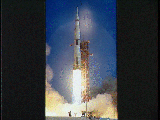 |
Space Shuttle
| Space Shuttle on launch pad | |
|---|---|
| Approximate parameters for the Space Shuttle (officially, the Space Transportation System or STS) are listed in the table below. A good Worldwide Web link for further information is NASA's Space Shuttle home page. | 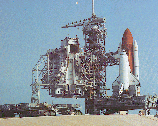 |
| Total length | 56 m |
| Total height | 23 m |
| Wingspan | 24 m |
| Mass at liftoff | 2x kg |
| Orbiter dry mass | 79,000--82,000 kg |
| Solid-rocket booster thrust, each of 2 | 15,000,000 N |
| SSME (main engine), each of 3 | 1,750,000 N |
Single-stage to orbit (SSTO)
| The Delta Clipper is a key candidate single-stage-to-orbit vehicle. The experimental version DC-X appears at right. Goals for the research program include complete reusability and minimal cost. Driving the concept of a single-stage-to-orbit vehicle is the premise that Earth launch will become affordable only when operations become similar to those of commercial airlines. NASA's main program for developing advanced launch systems is called the Long Term High Payoff Main Propulsion System Program. The DC-X program has evolved into the X-33 program. | 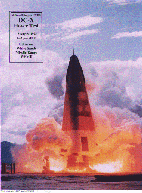 |
Useful references
Texts
George P. Sutton, Rocket Propulsion Elements (Wiley-Interscience, New York, 1992).Michael D. Griffin and James R. French, Space Vehicle Design (AIAA, Washington, DC, 1991).
Worldwide Web
The Jet Propulsion Laboratory (JPL) maintains a Web site, Basics of Space Flight, which gives a good tutorial introduction to many of the topics covered here.The Cambridge University Press's Handbook of Space Astronomy and Astrophysics contains an excellent chapter on Aeronautics and Astronautics, with parameters for many current launch vehicles.
Space-related, government, and other potentially useful Web sites
Questions
- Discuss the relative advantages of liquid propellants and solid propellants.
- Assuming that a rocket nozzle is designed to be most efficient part way along the rocket's flight path, explain the effects reducing efficiency before and after this point.
- Consider the problem of routine access to space from Earth's surface, and discuss the relative advantages and disadvantages of
- Heavy-lift launch vehicles, as epitomized by the Saturn V
- Space Shuttles
- Single-Stage to Orbit (X-33) vehicles
Dr. John F Santarius
Fusion Technology Institute,
University of Wisconsin-Madison
1500 Engineering Dr.
Madison, WI 53706
USA
415 Engineering Research Building
e-mail: santarius@engr.wisc.edu; ph: 608/263-1694; fax: 608/263-4499
Last modified: April 12, 1996
 |
|
University of Wisconsin Fusion Technology Institute · 439 Engineering Research Building · 1500 Engineering Drive · Madison WI 53706-1609 · Telephone: (608) 263-2352 · Fax: (608) 263-4499 · Email: fti@engr.wisc.edu |
Copyright © 2003 The Board of
Regents of the University of Wisconsin System.
For feedback or accessibility issues, contact
web@fti.neep.wisc.edu.
|
